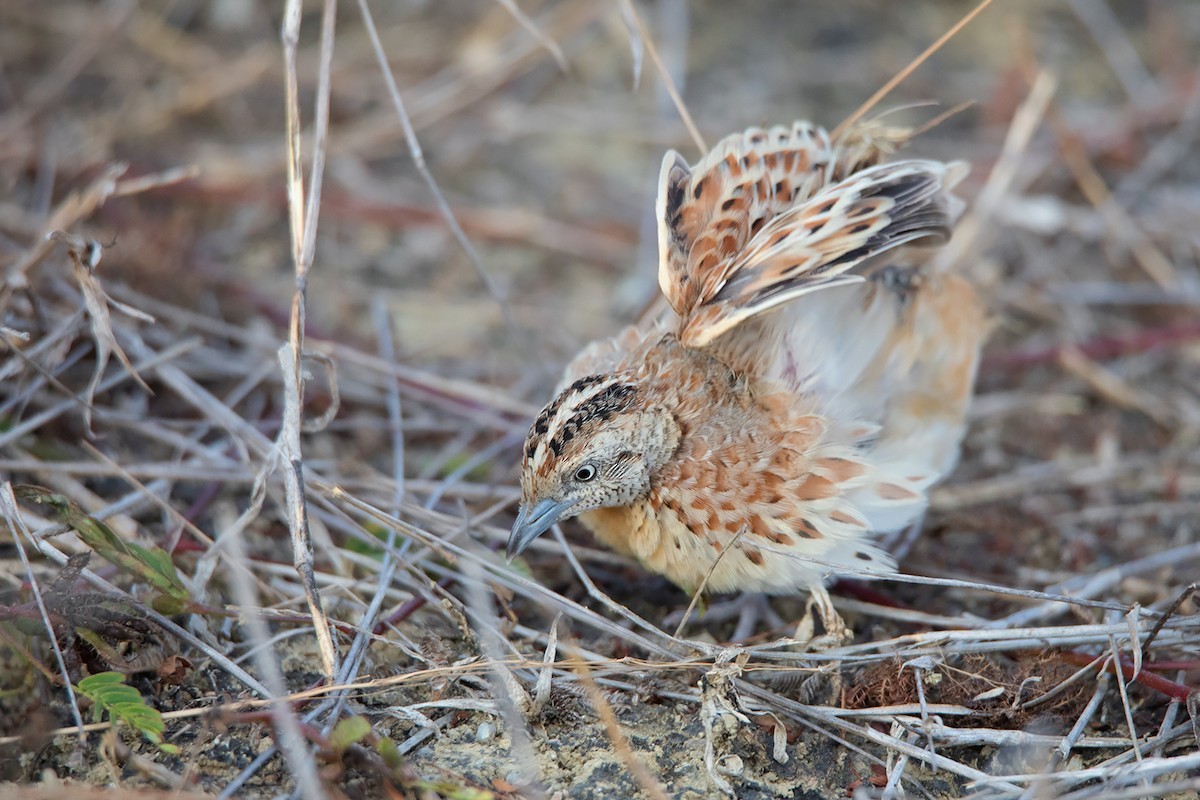Common Buttonquail
A species of Buttonquail, Also known as Striped Buttonquail Scientific name : Turnix sylvaticus Genus : Buttonquail
Common Buttonquail, A species of Buttonquail
Also known as:
Striped Buttonquail
Botanical name: Turnix sylvaticus
Genus: Buttonquail
Content
Description General Info
 Photo By Ayuwat Jearwattanakanok
Photo By Ayuwat Jearwattanakanok Description
The common buttonquail, Kurrichane buttonquail, small buttonquail, or Andalusian hemipode (Turnix sylvaticus) is a buttonquail, one of a small family of birds which resemble, but are unrelated to, the true quails. This species is resident from southern Spain and Africa through India and tropical Asia to Indonesia. This tiny buttonquail is notoriously difficult to see. It is a small, 15 cm (5.9 in) long drab running bird, which avoids flying. It inhabits warm grasslands or scrub jungle and feeds on insects and seeds. This species avoids thick forest and hilly country, and lives by preference in cornfields and stretches of grassy plain though it may also be found in any type of low herbage and open scrub jungle. It skulks and is flushed with difficulty, rising often close by one's feet. When flushed it flies low over the ground and soon settles again, after which it is very difficult to put up a second time. The common buttonquail resembles the common quail. It has streaked sandy brown upperparts, buff underparts with black flank markings, and a plain face. In flight, a whitish wingbar contrasts with the grey wing. Sexes are similar, but immature birds are more spotted below. The female initiates courtship and builds the ground nest. The male incubates the normally four speckled greyish eggs, and tends the young, which can run as soon as they are hatched. The nesting season is June to September. The nest is a slight pad of grass placed in a natural hollow in the ground where it is usually tucked away amongst the stems of a tuft of grass. Very occasionally the grass is bent over it in a sort of canopy. The female calls with a deep hoom-hoom-hoom and the male replies kek-kek-kek. Widespread throughout its large range, the small buttonquail is evaluated as least concern on the IUCN Red List of Threatened Species. However, the nominate subspecies which is distributed in the Mediterranean region is critically endangered. It disappeared from most of its range during the 20th century and is currently only present in Morocco after Spain officially declared the extinction of the species in 2018. This makes it the first bird species to become extinct in Europe since the Great Auk in 1852. Its name is derived from Kaditshwene (rendered as 'Kurrichane') in Botswana. 
Size
16 cm
Nest Placement
Ground
Feeding Habits
Common Buttonquail predominantly feeds on seeds, particularly grass seeds, and invertebrates like ants, with a diet varying between these food sources. Foraging involves ground scratching, and common Buttonquail is notably insectivorous during chick rearing, feeding them exclusively insects for ten days. While solitary or in pairs, common Buttonquail may forage in groups in winter, with peak activity in the early morning, late afternoon, or possibly nocturnally in the western Palaearctic.
Habitat
Common Buttonquail inhabits a range of dry, warm environments across Asia and sub-Saharan Africa. These birds are typically found in scrub jungles, bushy savannas, and grassy plains, as well as agricultural areas like crop fields. They thrive in regions with thick vegetation, such as thickets and tussocky grasslands, but notably avoid wetlands, preferring drier habitats than their relative T. hottentottus in overlapping areas.
Dite type
Granivorous
General Info
Feeding Habits
Bird food type

 Photo By Ayuwat Jearwattanakanok
Photo By Ayuwat Jearwattanakanok Scientific Classification
Phylum
Chordates Class
Birds Order
Shorebirds Family
Hemipodes Genus
Buttonquail Species
Common Buttonquail